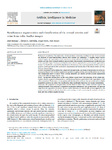Mostrar o rexistro simple do ítem
Simultaneous Segmentation and Classification of the Retinal Arteries and Veins From Color Fundus Images
| dc.contributor.author | Morano, José | |
| dc.contributor.author | Hervella, Álvaro S. | |
| dc.contributor.author | Novo Buján, Jorge | |
| dc.contributor.author | Rouco, J. | |
| dc.date.accessioned | 2021-09-07T17:13:04Z | |
| dc.date.available | 2021-09-07T17:13:04Z | |
| dc.date.issued | 2021 | |
| dc.identifier.citation | MORANO, J., HERVELLA, Á.S., NOVO, J. y ROUCO, J., 2021. Simultaneous segmentation and classification of the retinal arteries and veins from color fundus images. Artificial Intelligence in Medicine, vol. 118, pp. 102116. ISSN 0933-3657. DOI 10.1016/j.artmed.2021.102116. | es_ES |
| dc.identifier.uri | http://hdl.handle.net/2183/28434 | |
| dc.description.abstract | [Abstract] Background and objectives: The study of the retinal vasculature represents a fundamental stage in the screening and diagnosis of many high-incidence diseases, both systemic and ophthalmic. A complete retinal vascular analysis requires the segmentation of the vascular tree along with the classification of the blood vessels into arteries and veins. Early automatic methods approach these complementary segmentation and classification tasks in two sequential stages. However, currently, these two tasks are approached as a joint semantic segmentation, because the classification results highly depend on the effectiveness of the vessel segmentation. In that regard, we propose a novel approach for the simultaneous segmentation and classification of the retinal arteries and veins from eye fundus images. Methods: We propose a novel method that, unlike previous approaches, and thanks to the proposal of a novel loss, decomposes the joint task into three segmentation problems targeting arteries, veins and the whole vascular tree. This configuration allows to handle vessel crossings intuitively and directly provides accurate segmentation masks of the different target vascular trees. Results: The provided ablation study on the public Retinal Images vessel Tree Extraction (RITE) dataset demonstrates that the proposed method provides a satisfactory performance, particularly in the segmentation of the different structures. Furthermore, the comparison with the state of the art shows that our method achieves highly competitive results in the artery/vein classification, while significantly improving the vascular segmentation. Conclusions: The proposed multi-segmentation method allows to detect more vessels and better segment the different structures, while achieving a competitive classification performance. Also, in these terms, our approach outperforms the approaches of various reference works. Moreover, in contrast with previous approaches, the proposed method allows to directly detect the vessel crossings, as well as preserving the continuity of both arteries and veins at these complex locations. | es_ES |
| dc.description.sponsorship | This work is supported by Instituto de Salud Carlos III, Government of Spain, and the European Regional Development Fund (ERDF) of the European Union (EU) through the DTS18/00136 research project; Ministerio de Ciencia e Innovación, Government of Spain, through the RTI2018-095894-B-I00 and PID2019-108435RB-I00 research projects; Xunta de Galicia and the European Social Fund (ESF) of the EU through the predoctoral grant contract ref. ED481A-2017/328; Consellería de Cultura, Educación e Universidade, Xunta de Galicia, through Grupos de Referencia Competitiva, grant ref. ED431C 2020/24. CITIC, Centro de Investigación de Galicia ref. ED431G 2019/01, receives financial support from Consellería de Educación, Universidade e Formación Profesional, Xunta de Galicia, through the ERDF (80%) and Secretaría Xeral de Universidades (20%) | es_ES |
| dc.description.sponsorship | Xunta de Galicia; ED481A-2017/328 | es_ES |
| dc.description.sponsorship | Xunta de Galicia; ED431C 2020/24 | es_ES |
| dc.description.sponsorship | Xunta de Galicia; ED431G 2019/01 | es_ES |
| dc.language.iso | eng | es_ES |
| dc.publisher | Elsevier | es_ES |
| dc.relation | info:eu-repo/grantAgreement/MICINN/Plan Estatal de Investigación Científica y Técnica y de Innovación 2017-2020/DTS18%2F00136/ES/Plataforma online para prevención y detección precoz de enfermedad vascular mediante análisis automatizado de información e imagen clínica | |
| dc.relation | info:eu-repo/grantAgreement/AEI/Plan Estatal de Investigación Científica y Técnica y de Innovación 2017-2020/RTI2018-095894-B-I00/ES/DESARROLLO DE TECNOLOGIAS INTELIGENTES PARA DIAGNOSTICO DE LA DMAE BASADAS EN EL ANALISIS AUTOMATICO DE NUEVAS MODALIDADES HETEROGENEAS DE ADQUISICION DE IMAGEN OFTALMOLOGICA | |
| dc.relation | info:eu-repo/grantAgreement/AEI/Plan Estatal de Investigación Científica y Técnica y de Innovación 2017-2020/PID2019-108435RB-I00/ES/CUANTIFICACION Y CARACTERIZACION COMPUTACIONAL DE IMAGEN MULTIMODAL OFTALMOLOGICA: ESTUDIOS EN ESCLEROSIS MULTIPLE | |
| dc.relation.uri | https://doi.org/10.1016/j.artmed.2021.102116 | es_ES |
| dc.rights | Atribución-NoComercial-SinDerivadas 4.0 Internacional (CC BY-NC-ND 4.0) | es_ES |
| dc.rights.uri | http://creativecommons.org/licenses/by-nc-nd/4.0/ | * |
| dc.subject | Artery and vein classification | es_ES |
| dc.subject | Deep learning | es_ES |
| dc.subject | Medical imaging | es_ES |
| dc.subject | Ophthalmology | es_ES |
| dc.subject | Retina | es_ES |
| dc.subject | Vessel segmentation | es_ES |
| dc.title | Simultaneous Segmentation and Classification of the Retinal Arteries and Veins From Color Fundus Images | es_ES |
| dc.type | info:eu-repo/semantics/article | es_ES |
| dc.rights.access | info:eu-repo/semantics/openAccess | es_ES |
| UDC.journalTitle | Artificial Intelligence in Medicine | es_ES |
| UDC.volume | 118 | es_ES |
| UDC.startPage | 102116 | es_ES |
| dc.identifier.doi | 10.1016/j.artmed.2021.102116 |
Ficheiros no ítem
Este ítem aparece na(s) seguinte(s) colección(s)
-
GI-VARPA - Artigos [59]






